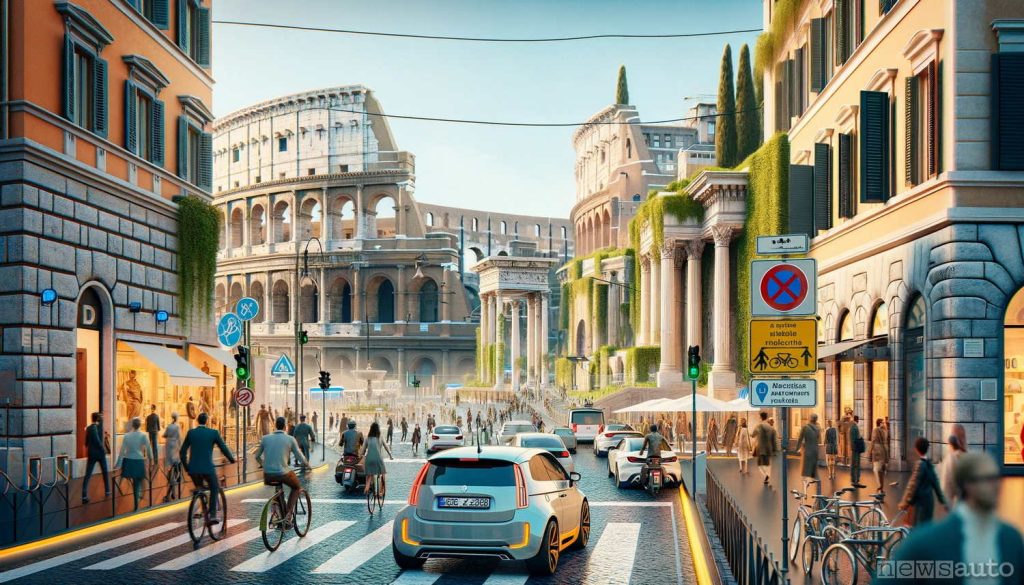Car circulation in the center of Rome will be subject to a fee. After Milan Also Rome is preparing to realize his Area C and to revolutionize the mobility of the Center in view of Jubilee of 2025. The so-called Congestion Charge will come into operation by first six months of 2026 and it will be an access fee similar to the area C of Milancovering a large area of the city which includes the historic center and partly the Prati and Trionfale districts, Testaccio, San Giovanni, Ostiense, Gianicolense, Monteverde up to Castel Sant'Angelo and the Vatican.
Paid car circulation in Rome, where and when
The area subject to toll payment, called ZTL VAMincludes more 23 square kilometerswhich include the historic centre, the Prati and Trastevere districts, the Termini Station area and of Porta Piaas well as the suburban areas of Aurelio And Testaccio. The streets that delimit the perimeter include Ponte Duca d'Aosta, Lungotevere Flaminio, Lungotevere delle Navi, part of Corso d'Italia, Viale Castro Pretorio, Viale Pretoriano, Viale Castrense up to Piazzale Appio, Via Sannio, Piazzale Ipponio, Via Ipponio, Piazzale Metronio, continuing along Viale Metronio up to Viale delle Mura Latine. From there, it crosses Viale di Porta Ardeatina, Piazzale Ardeatino, Piazzale Ostiense, Piazza di Porta San Paolo, Via Marmorata up to the junction point with the Limited Traffic Zone (ZTL) of the center and then heads towards Galvani and Testaccio.
The toll area in Rome includes the following roads and borders:
- It starts from Ponte Duca d'Aosta and proceeds along Lungotevere Flaminio.
- Continue along Lungotevere delle Navi.
- Part of Corso d'Italia is included in the paid area.
- Continue along Viale Castro Pretorio.
- Cross Viale Pretoriano.
- Continue on Viale Castrense up to Piazzale Appio.
- From Piazzale Appio, proceed along Via Sannio.
- Cross Piazzale Ipponio.
- Continue on Via Ipponio.
- Arrives at Piazzale Metronio.
- From there, continue along Viale Metronio to Viale delle Mura Latine.
- Continue on Viale di Porta Ardeatina.
- Cross Piazzale Ardeatino.
- Pass through Piazzale Ostiense.
- Arrives at Piazza di Porta San Paolo.
- It continues along Via Marmorata up to the junction point with the Limited Traffic Zone (ZTL) in the centre.
- From there, it heads towards Galvani and Testaccio.
Next, cross several streets, including Via Beniamino Franklin, Via Aldo Manuzio, Lungotevere Testaccio, Ponte Testaccio, Via Bernardino Passeri, Via Carlo Porta, Viale Trastevere, Circonvallazione Gianicolense, Piazzale Dunant, Viale Quattro Venti, Via Francesco Maidalchini, Via di Donna Olimpia, Via Vitellia, Via Leone XIII, Via Giuseppe Spina, Via Aurelia Antica, Via di Villa Betania, Via Nicolò Piccolomini, then returning to Via Leone XIII, continuing towards Via Filippo Bernardini, Piazza Pio XI, Via Anastasio II, Via Innocenzo XIII , Via Angelo Emo, Via Marcantonio Bragadin, Via Cipro, Circonvallazione Trionfale, Circonvallazione Clodia, Piazzale Clodio, Via Capo di Prati and finally returning to Ponte Duca d'Aosta.
- From Via Beniamino Franklin.
- Continue on Via Aldo Manuzio.
- Continue on Lungotevere Testaccio.
- Cross Ponte Testaccio.
- Continue on Via Bernardino Passeri.
- Continue on Via Carlo Porta.
- Cross Viale Trastevere.
- Continue on Circonvallazione Gianicolense.
- Arrives at Piazzale Dunant.
- From there, proceed onto Viale Quattro Venti.
- Continue on Via Francesco Maidalchini.
- Continue on Via di Donna Olimpia.
- Cross Via Vitellia.
- Continue on Via Leone XIII.
- Continue on Via Giuseppe Spina.
- Continue on Via Aurelia Antica.
- Continue on Via di Villa Betania.
- Continue on Via Nicolò Piccolomini.
- Then return to Via Leone XIII.
- Continue on Via Filippo Bernardini.
- Arrives at Piazza Pio XI.
- Continue on Via Anastasio II.
- Continue on Via Innocenzo XIII.
- Continue on Via Angelo Emo.
- Continue on Via Marcantonio Bragadin.
- Continue on Via Cipro.
- Continue on Circonvallazione Trionfale.
- Continue on Circonvallazione Clodia.
- Arrives at Piazzale Clodio.
- Continue on Via Capo di Prati.
- And finally returns to Ponte Duca d'Aosta.
Limited access to Rome
As in Milan, Rome will also follow a model that allows one number limited access. Residents within the new Limited Traffic Zone (Ztl) will have to obtain a mark and pay the tax, similar to what residents in the historic center are currently required to do. Even those who live outside the area subject to the “Pollution Charge” will be able to purchase the access permitand could be considered daily access methods.

Details on costs and free access, intended for those who request and obtain permission, are still being evaluated. Additionally, the city is looking into a system based on mileage which could involve counting mechanisms installed on vehicles, such as the use of Move-In black box.
Congestion Charge Rome
There Congestion Charge is a type of tariff or tax (tax) that is applied in some cities or urban areas to reduce environmental pollution. The basic principle is to discourage the use of vehicles that emit a high level of pollutants, such as those with petrol or diesel engines, especially in areas with high traffic density or in urban areas where air pollution is a significant problem . There “Congestion Charge” in Rome it will be applied to all vehicles a internal combustion engine and according to the Municipality of Rome, anyone who wants to access the center with a private vehicle from 2026 will have to pay a tax.

To manage payments, an evolution towards electronic toll and integrated systems, with the creation of an electronic access control system using cameras.
The public money allocated by this tax, which severely limits the freedom of movement of the Romans, will finance the creation of special software which will allow the entry of vehicles into the historic center to be monitored.
Electric vehicles will not have to pay pollution tax.

Read also:
→ New ZTL Green Zone bans
→ Move-In black box how it works
→ What do you think? Drop by discussions on the FORUM!
#Car #circulation #Rome #limited #paid #access
